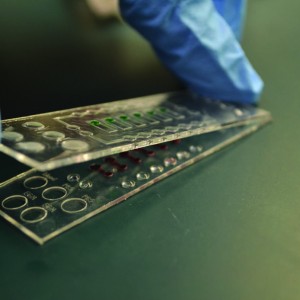A team of researchers funded by the National Institute of Biomedical Imaging and Bioengineering led by David Beebe, Ph.D., Director of the Microtechnology, Medicine, and Biology lab at the University of Wisconsin, developed a handheld device to diagnose asthma from a single drop of blood by assessing a specific feature of neutrophils that differs between in asthmatic and non-asthmatic patients. In asthmatic patients, Neutrophils migrate to the lungs when other cells of the immune system within the lung tissue become stimulated and begin to release type of proteins called chemokines.
The new handheld device is a microfluidic device that assesses neutrophil characteristics as they move in response to chemokines, a process called chemotaxis. On the base of the device the researchers created multiple small channels that contain a protein called P-selectin. When the blood is run through these channels, neutrophils bind to the P-selectin. To trigger chemotaxis, the lid of the device has chemokines to attract neutrophils. As the neutrophils travel towards the chemokines, photos of the neutrophils are taken under a microscope. Then with software the investigators are able to measure the absolute migration speed, the chemotaxic index and the chemotaxis velocity.
The new device was tested in a clinical trial with 34 individuals, 23 asthmatics and 11 with a diagnosis of non-asthmatic allergic rhinitis. Eric Sackmann, Ph.D. and Sameer Mathur, M.D., Ph.D., Associate Professor of Medicine at the University of Wisconsin School of Medicine and Public Health led the trial. Findings showed that absolute migration speed and the chemotaxic index did not differ between groups; the neutrophils of the asthmatic patients had a lower chemotaxis velocity. Based on the results, the researchers concluded that the test provides a quantitative result, is able to determine asthma severity, and can help in conducting routine evaluations. The device is easy to use and can assess asthma in less than 5 minutes, making it optimal for children and older people. The device can also be used to explore the function of neutrophils in other inflammatory conditions. The study reporting the results was published last April in PNAS.
[adrotate group=”3″]
“Every day scientists make great strides in understanding the biological basis of disease. But simply knowing how we get sick is not enough. When we can combine this knowledge with technological innovation to design better, faster, cheaper, and easier-to-use diagnostic systems, then we’ve done something exceptional,” said Rosemarie Hunziker, Ph.D., a program director at NIBIB in a recent news release. “This device is another great example of NIBIB’s commitment to support the development of technologies that will have big impacts on healthcare.”


